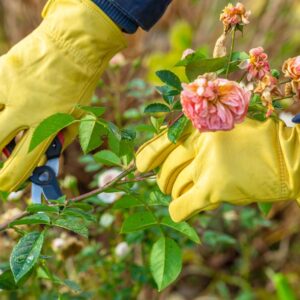There are numerous reasons behind the practice of pruning. It increases airflow through the shrub by removing dead and diseased canes (branches) minimizing the risk of diseases and certain pests. Pruning revitalizes the rose bush and promotes new blooms and new shoots, keeps their size under control, and increases the number of flowers. In this article, I’ll go over some of the key points you’ll need to know when caring for your roses to keep them at the peak of health.
Choose the Right Time
The best time of year to prune roses depends greatly on two factors. Your location’s growing season and the variety of roses you are pruning.
As a rule of thumb, pruning should be done when rose bushes are dormant so that the pruning won’t encourage tender new growth that will be damaged by late or early frosts. Your exact time will be determined by where you are. Some veteran gardeners will time their pruning based on when a specific plant in their area begins to bloom. Consult with your local nursery for specific times in your location.
Know your Rose Variety
Not all roses are pruned the same or at the same frequency and it’s very important to know the variety of the rose bush. Although there are hundreds of species and thousands of varieties, roses are generally classified into categories: old garden roses, climbing roses, wild roses, and modern roses. Old Garden, climbing roses, and wild rose varieties will generally bloom once or twice in a season. The best time to prune these will be after their blooming cycle is finished rather than a certain time of year.
There are some varieties that only bloom on second year canes. If you aren’t sure what variety you have, find an expert that can help you identify your rose bush before you begin pruning.
Tools You Will Need
- Gauntlet gloves and a long-sleeved shirt
- Bypass Pruning shears. Bypass sheers have two curved blades that “bypass” each other much like the blades on a pair of scissors. One blade is sharp, with the other dull, which gives a clean cut as long as the tool remains sharp. A clean cut is required which is what makes this type of shear the best to use.
- Rubbing alcohol for disinfecting your shears before and after pruning
- Protective eyewear
Pruning Steps
- Begin by disinfecting your shears with rubbing alcohol.
- Make all cuts at an angle. Cutting at an angle helps the water to drain away from the new cut which aids in disease prevention.
- Start by removing any dead, diseased, or damaged branches along with any faded blooms. Dead canes will not be pliable. Diseased canes will have discoloration caused by fungus or parasites. Cut these canes to the base of the plant.
- Roses require good air circulation so next you thin out the center of the bush and remove any crossing branches that are growing towards the middle.
- Cut back any weak or spindly branches to their main stem.
- Look for suckers from a grafted rose, which is growth that comes off the root. Scrape back the earth and cut back to below the surface and cover it with dirt.
- Prune all remaining healthy canes back by about one-third of the total length. Don’t cut back more than a third of the entire length as this can put too much stress on the plant. Cuts should be made at a 45-degree angle outward. Ideally this will be just above a place on the cane with 5 to 7 leaflets.
- Step back and look it over for size and shape. Make a few more cuts for size and shape if need be.
- Remove the waste. It’s best not to compost in the event of diseased branches.
- After you have finished pruning, disinfect your shears again. This will help to prevent the spread of disease.
Here are some additional tips when pruning rose bushes:
- Prune in the evening to prevent the sun from burning the newly cut stems.
- Use sharp pruning shears. Dull shears will crush the stems and make them more susceptible to disease.
- Water and fertilize the rose bush after you’re finished pruning. This will help the plant to recover from the pruning.
- Spent blooms can be cut back at any time. “Deadheading” allows the plant’s energy to produce new and healthier blooms.

